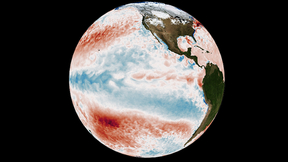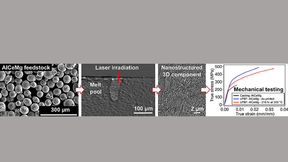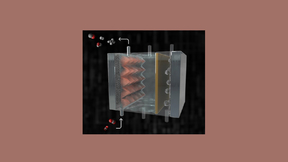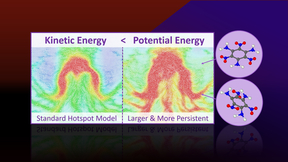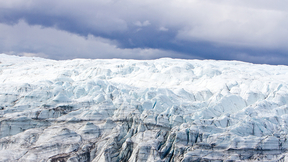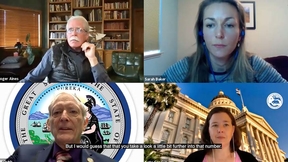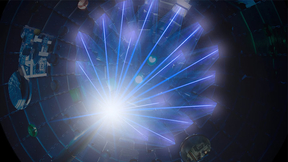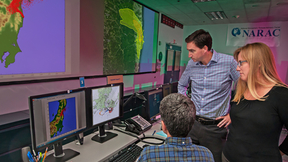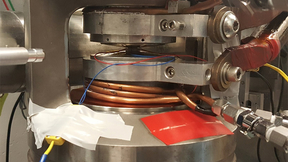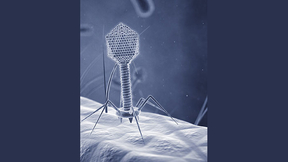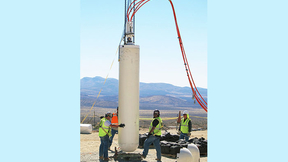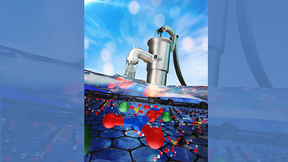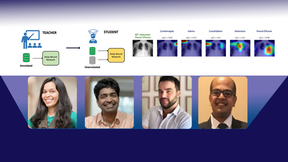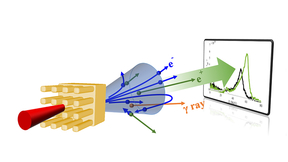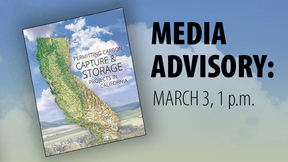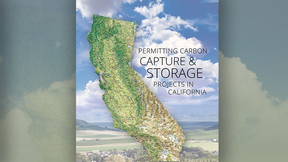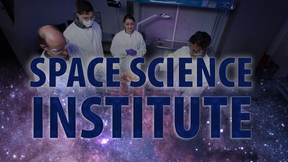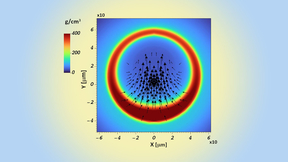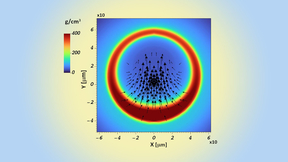Back
Physical and Life Sciences
Natural variations help resolve a climate puzzle
New research shows that naturally occurring climate variations help to explain a long-standing difference between climate models and satellite observations of global warming. Satellite measurements of global-scale changes in atmospheric temperature began in late 1978 and continue to the present. Relative to most model simulations, satellite data has consistently shown less…
Enhancing the mechanical performance of aluminum alloys
Laser powder bed fusion (LPBF) is a prominent additive manufacturing (AM) process that fuses thin layers of metal powder to underlying layers using laser melting in a sequential process. However, the high cooling rates and peak surface temperatures of the LPBF process can cause solidification defects in lightweight materials such as aluminum (Al) alloys, which have poor…
3D-printable gas diffusion layers promise improved performance in electrochemical reduction of CO2
Using carbon dioxide (CO2) emissions to create value-added products is an attractive approach to reduce net greenhouse gas emissions. Processes such as the electrochemical reduction of CO2 to ethylene and ethanol offer a pathway to producing commodity chemicals without fossil fuels when they are powered using low-carbon electricity. Gas diffusion electrode (GDE) assemblies…
Research uncovers missing physics in explosive hotspots
Research conducted on Lawrence Livermore National Laboratory’s (LLNL) supercomputer Quartz highlights findings made by scientists that reveal a missing aspect of the physics of hotspots in TATB (1,3,5-trimamino-2,4,6-trinitrobenzene) and other explosives. Hotspots are localized regions of elevated temperature that form from shock-induced collapse of microstructural…
Greenland landscape history preserved under ice sheet
Greenland wasn’t always covered in ice. In fact, within the last 1.1 million years, Greenland had thriving vegetation and ecosystems. That is the conclusion of an international group of researchers, including a scientist from Lawrence Livermore National Laboratory (LLNL), that analyzed sediment at the base of the Camp Century ice core (1.4 kilometers deep) collected in…
No miracles required: Scientists, industry experts agree California’s carbon capture and storage can be a reality
When it comes to California implementing a carbon capture and storage program to reach the state’s goal of carbon neutrality by 2045, nothing too newfangled needs to take place. During a forum titled “Carbon Capture and Sequestration in California: Regional Insights and Community Attitudes,” a group of scientists, California policymakers and industry leaders came together…
Stepped-up U.S. investment in fusion energy
An influential Department of Energy (DOE) advisory committee has recommended that the nation move aggressively toward the deployment of fusion energy, including investments in technology and equipment to support one of the core missions of LLNL’s National Ignition Facility (NIF) — laying the groundwork for the development of inertial fusion energy (IFE). The report,…
Ten-year anniversary of Fukushima observed
Ten years ago today, on March 11, 2011, a 9.0 Richter-scale earthquake and tsunami in Japan resulted in severe damage to the Fukushima Dai-ichi nuclear power plant and also led to releases of radioactivity into the environment. That same day, the U.S. Department of Energy (DOE) activated Lawrence Livermore National Laboratory’s National Atmospheric Release Advisory Center …
Research identifies a pressure-induced increase in efficiency, phase transition of thermoelectric materials
Researchers have shown how applying pressure to a specific thermoelectric material, TiNiSn, increases its efficiency and leads to a structural phase transition. Thermoelectric materials are materials that can provide energy without the need for mechanical parts by converting heat energy into electrical energy. Thus, research aimed at these materials can identify new, more…
LLNL and NPS ink MOU for collaboration
Whether working informally or through a collaboration agreement, Lawrence Livermore National Laboratory (LLNL) and the Monterey-based Naval Postgraduate School (NPS) have enjoyed an enduring relationship for more than two decades. While the two institutions have worked together informally for years, until recently they had only one memorandum of understanding (MOU)…
Fighting Bacterial Infections with Machine Learning
Scientists in the Forensic Science Center at Lawrence Livermore have partnered with San Diego State University and UCSD to advance bacteriophage therapy.
Seismic Sleuths Set Off the Source Physics Experiment
The Source Physics Experiment improves the identification of nuclear events, and the ability to tell them apart from non-nuclear occurrences.
Tailored Water Treatment Ready to Clean Up
Livermore scientists working alongside Stanford University researchers have made headway toward a new generation of tailored, reversible water treatment.
'Self-trained' deep learning to improve disease diagnosis
New work by computer scientists at Lawrence Livermore National Laboratory (LLNL) and IBM Research on deep learning models to accurately diagnose diseases from X-ray images with less labeled data won the Best Paper award for Computer-Aided Diagnosis at the SPIE Medical Imaging Conference on Feb. 19. The technique, which includes novel regularization and “self-training”…
Doubling creation of antimatter using same laser energy
Lawrence Livermore National Laboratory (LLNL) scientists have achieved a near 100 percent increase in the amount of antimatter created in the laboratory. Using targets with micro-structures on the laser interface, the team shot a high-intensity laser through them and saw a 100 percent increase in the amount of antimatter (also known as positrons). The research appears in…
Media advisory: Energy experts to discuss carbon capture, storage and regulations for California
WHO George Peridas, director of carbon management partnerships, and staff scientist Briana Schmidt from Lawrence Livermore National Laboratory. Peridas is responsible for incubating partnerships that result in the advancement and deployment of carbon management solutions and technologies, including the removal of carbon dioxide from the atmosphere, or so-called negative…
Lab report outlines updates to state’s regulations for carbon capture, storage in effort to achieve neutrality
To reach economy-wide carbon neutrality by 2045 or earlier, California will likely have to capture, transport and geologically store tens of millions of tons per year of carbon dioxide (CO2) from large sources and from the atmosphere. California has an extensive regulatory framework that is rigorous, robust and will safeguard the environment, public health and safety…
Lab launches interdisciplinary Space Science Institute
What are the next world-class, game-changing concepts and technologies that will address the most important questions in astrophysics or planetary science? Lawrence Livermore National Laboratory (LLNL) researchers will soon be better equipped to answer this question with the launch this month of a new Space Science Institute (SSI), intended to boost cross-discipline…
Study reveals cause of 3D asymmetry in ICF implosions
Inertial confinement fusion (ICF) implosions require very high levels of symmetry in order to reach the high densities and temperatures required for fusion induced self-heating. Even percent-level deviations from perfect spherical symmetry can lead to significant distortions of the implosion and ultimately degrade fusion performance. To that end, researchers from Lawrence…
Study reveals cause of 3D asymmetry in ICF implosions
Inertial confinement fusion (ICF) implosions require very high levels of symmetry in order to reach the high densities and temperatures required for fusion induced self-heating. Even percent-level deviations from perfect spherical symmetry can lead to significant distortions of the implosion and ultimately degrade fusion performance. To that end, researchers from Lawrence…


